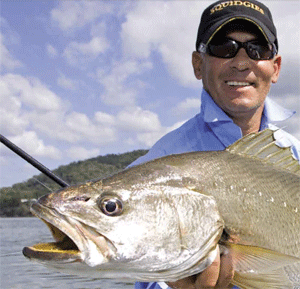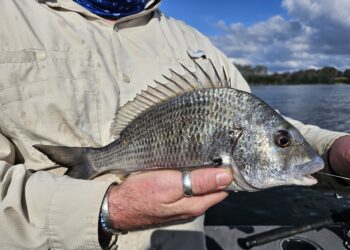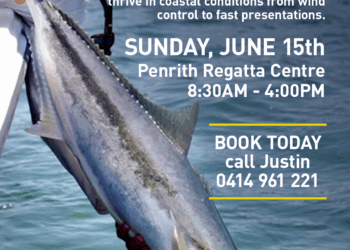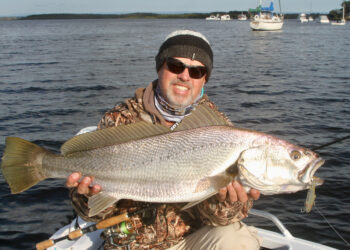Estuary Livebaiting
There’s a lot of mystery about catching jewfish. But KEVIN SAVVAS reckons that’s all a load of bollocks – all you need is a good supply of livebaits and you’re on your way to jewie stardom!
I THINK I’ve turned into a fishing snob. Over the past decade I’ve scoffed at those who use bait to catch fish. In my pursuit to learn how to use lures, I’ve definitely developed an elitist attitude. I guess I considered catching fish on lures to be more challenging task than using bait. However, recent sessions fishing for jewies with livebait has re-enlightened me. The skill level of effective bait fishing is every bit as demanding as luring. There’s more to it than just staring at rod tips waiting for some action.
My fishing pedigree is firmly entrenched in bait fishing. My family of fishing tragics has been pestering our local river for over 40 years. In that time we’ve have learnt a thing or two about successfully fishing the system, in particular, fishing livies for jew. Over the past few months, I’ve been reminiscing about the long sessions anchored up silently waiting for a baitrunner style reel to explode to life. I forgot how tranquil the whole process is, and just how special catching a jewie on livebait can be.
This piece will outline how we go about catching these wily critters, not just from a boat, but land-based as well. Jewies are a legitimate target if you don’t have a boat. I will also dispel a few myths associated with this species and highlight where to look and what baits will unlock the most jaws.
Boat Tactics
When I target jewies in my boat, 99 per cent of the time it is in daylight hours. The myth that jewies are best caught at night is incorrect. To be honest, I’m not quite sure where it started. Jewie movements are now more publicised than they used to be, thanks in part to the studies being conducted by Fisheries departments, and it’s common knowledge that jewies will hunt their prey at night and “hole up” during the day to rest. This doesn’t mean while a jewie is holed up it won’t eat, but it does mean they are easier to find and catch.
It makes sense. Active jewies hunting prey at night can be anywhere in the system and it’s pot luck if one happens to swim past your bait. Effectively, you need them to find you. During the day they are sedentary, meaning the reverse happens: you find them and present bait to them.
So where are they holed up during the day? If I were a betting man I would be looking for the deepest hole you can find. The deeper the water, the less tidal flow or surge there is. Jewies, like most big estuary species, are very lazy and will station themselves in positions where they will expel the least amount of energy. Look for deep water with eddies, big drop-offs, behind points or islands, or anywhere that’s deflecting the flow of water. This usually provides a place out of the main current but close enough to capitalise on an easy meal if one presents itself. If you can find a deep hole, an eddy and hard reef bundled together, you’re laughing.
Once the deep hole is located, I like to anchor my boat up current of the hole so my livies are placed at the base of the drop-off. Jewies will sit nose into the current waiting for food to be swept into the hole, usually looking up at what’s being swept over the edge. I usually don’t do very well if the baits are positioned well inside the hole. The leading edge is far more successful.
When anchoring, I will anchor from the nose of my boat and fish four lives out the back at various distances behind the transom. Any more than that, the livies tend to tangle each other. If I have a few different lives at my disposal, such as slimies and yakkas, I will usually stagger them. This way a jewie can work its way up my livies till it finds one it’s interested in; much like a spread of trolled lures for marlin. I sometimes will deploy two anchors, one from the nose and one from the rear and fish sideways if the current is minimal so I can hold position.
Land-based Tactics
When I chase jewies from shore I do a complete reversal of my approach in a boat. First off, I tend to fish at night. The reason for this is fishing from shore is quite restricted and productive spots are hard to come by. I can’t pack up my gear, livebait and berley as easily and change spots. I need the fish to find me. Therefore, night-time provides me that luxury and really it’s about playing the odds. I don’t hook as many fish from shore, maybe because it’s not my ideal thing, but for those without access to a boat catching jew from shore can be productive if you put in the hours.
When looking for a place to fish, I tend to look for access to a channel. When jewies are on the move, at some point they will use the main channels to migrate up and down the waterway looking for food. Therefore wharves, pontoons, jetties, prominent points and headlands with access to deep water are great places to prospect. The bonus is that bait usually congregates in these areas so catching fresh livies shouldn’t be a problem.
In Sydney, the ferry wharves that are lit up well at night usually produce a jewie or two. The lights bring the baitfish which in turn lures the jewie. Also on the lights theme, probably the best-known jewie haunt is fishing lit bridges at night. We have hooked jewies to 28kgs in less than two metres of water at night so don’t be fooled into thinking big, expansive bridges are the only option. Innocuous bridges tucked away in small tributaries will produce at the right time. Look for the big tides for best results in the shallow stuff.
The Best Bait
Regardless of how good a fisherman you are, when it comes to jewfish you are only as good as your ability to catch livebait. You might have the perfect run-out tide coinciding with daybreak but unless you can get a few baits in the livewell you might as well fish for something else. While some people will tell you that butterflied or slab baits are good, the truth is the best success comes from using livebait. The only dead bait I will use for jewies is squid and the reason for this is I hate pickers. I hate rigging a perfect slab of mullet or tailor only to have it picked to bits by a horde of baby snapper or bream. Livies stay relatively untouched till a decent fish comes along.
In selecting appropriate baits, it is a good idea to look within your own waterway and see what is available. “Match the hatch” is a common cliché lure fishos use when trying to replicate a local food supply with lures but it’s just as significant with bait. If your river system holds good numbers of yakkas and herring, these will be the best baits to use. Ditto with mullet or just legal tailor. Also, the best livie to use may change within the one system. In my local river, the local baitfish supply in the upper reaches is tailor. As you head towards the sea the bait supply changes to herring in the middle reaches then yakkas close to the mouth. If I fill my livewell with yakkas and head upstream into herring territory, my chances of hooking a jewie diminishes. You have to feed them what they are looking for.
When I rig my livies I prefer to place the hook in the back towards the tail. This causes the fish to swim away from the line and resists tangling, plus it keeps the bait in good condition for longer. Some people like to rig the bait through the nose or eyes and while this is good in extra strong current, I think the hook up rate decreases and the livie tends to tire quicker and put out fewer vibrations.
The Technique
There are many variations on how to hook and land jewies. Some prefer to keep their reels in strike and let the fish hook themselves while others like to let the fish run with the bait before setting the hook. Here’s my theory: Unless you’re using circle hooks, which I don’t as I prefer to use octopus-style hooks for livebaits, I will always use my Baitrunner feature and allow the fish to take the bait unrestricted. The reason for this lies in the way jewies hit their prey. For those who have never tied on livebait, they begin to kick erratically when they sense a predator nearby. This can be seen through the rod tip. Usually this is followed by a jewie grabbing the bait and taking a short first run of no more than 10–15m. At this point the jewie has mouthed the bait, moved away from the strikezone and will turn the livie so it goes down head first. Then the reel will scream in full flight on the second run. Now is the time to engage the reel and strike hard. It’s difficult at times to show patience and wait for the second run but it’s well worth it as your hook up rate will increase. The downside is most of the jew will be gut hooked or, at a minimum, hooked deeply.
There are times, however, that I will fish a reel in strike. If I am using live or stripped squid I will use a snelled hook rig with the first hook, which is placed in the squid’s cape, being a circle hook. This will ensure the fish will hook itself once it attacks the bait. The reason for this is a squid has no fins. A jewie can attack it from any angle and get it down in any fashion. A fish, on the other hand, must be taken head first. If it goes down backwards, the jewie will run the risk of choking to death. That’s where the second run theory comes into play.
Also, I prefer to cast out my livies. I don’t like to fish them straight down beneath my boat as some people do. Jewies spook easily so the further away I can get my livies the better. This is the same for land based fishos as well.
Rigs & Tackle
If I am fishing from my boat or from shore, I run two completely different rigs. From my boat I use a running sinker dropper rig. The rig allows the livie to be suspended off the bottom and is especially effective in current, which is usually present where I do my jewie fishing. By lifting the bait off the bottom you stay away from rays and mud crabs and can be changed to suit conditions as jewies will hit bait well off the bottom at times. Sometimes it’s more effective to use a dropper of a metre or more, other times it works well with a short dropper of 30cms. The general rule is more current, less dropper. The line connecting to the sinker should be lighter than the trace and mainline. Once snagged, the sinker will break off and you won’t have to retie your whole rig.
From shore, whether from a wharf, headland or beach, I like to use a conventional running sinker rig. The dropper rig can become tangled if there is no current and a long trace on a conventional rig will still allow the bait to swim freely in these areas.
Also, the rig can be cast better which is particularly important, as long casts are necessary from land. You want to get your offering well into the channel and in the path of a travelling jewie.
At the business end, I tend to use 7/0 Octopus style hooks as I have found these have the best hook-up rate. If your bait is particularly small or overly large you can use either a 6/0 or 8/0 accordingly. I like either Gamakatsu or Owner hooks. While you will pay a premium, for the hours you put in to catch a fish you don’t want to be found out with substandard terminals.
From my boat I will use 7’ rods in the 6-10kg class with 4500 sized Shimano Baitrunners. I run 20lb mono or braid mainline, I mix it up a little here, and upscale to a 40lb fluorocarbon shock leader. From shore, I will use beach rods regardless where I’m fishing. The reason for this once again is casting distance. Ten to 12 foot rods cast well and the extra reach they offer is vital in guiding the fish away from hazards such as rocks or pylons when they are close to the net. With my beach rods I run Shimano Thunnus 16000s loaded with 30lb mono and 40lb fluorocarbon leader. The larger reel is purely for a bit of extra line capacity in case an XOS fish happens to come along.
The Best Time
I often get asked, “when is the best time to catch a jewie?” and over the years I’ve heard just about all the different permutations. Some old salts will tell you a few days before the new moon, others will tell you a few days after the full moon. Some like a run-in tide at dusk while others like a high barometer. The fact is if you listened to all this you’d never find the right time to catch one. The fact is that the best time to catch a jewie is when you have time to go fishing. There is no one perfect time. It can happen at any time.
In saying this, once again if I were a betting man, my favourite time is a run-out tide at dawn. Also, remember the famous saying of “no run, no fun”. A bit of current is just about always a positive sign. The take-home message, however, is just get out there and give it a go. Forget about reading into it too much. Fish need to eat and they couldn’t give a stuff about what moon phase or tidal phase it is. If there is an easy meal on offer they won’t refuse it.


















